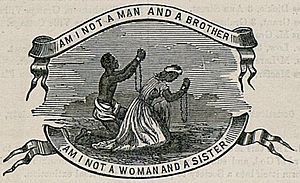Edinburgh Ladies' Emancipation Society facts for kids
The Edinburgh Ladies' Emancipation Society was a very important group of women in Edinburgh, Scotland, during the 1800s. They were leaders in the movement to end slavery. These women are remembered as "heroines" because of their strong efforts to fight for freedom. Their work had a big impact on the fight against slavery.
Contents
How the Society Started
The Edinburgh Ladies' Emancipation Society began a little later than some other groups. On October 7, 1833, several anti-slavery groups were formed. These included the Edinburgh Emancipation Society and the Glasgow Ladies' Emancipation Society. The Edinburgh groups were set up to support George Thompson. He had been invited to visit America by the New England Emancipation Society. This American group was led by William Lloyd Garrison, who was only 28 years old.
A Split in the Movement
These societies often invited speakers who were against slavery to give talks. However, the Edinburgh Ladies' society later stopped inviting speakers from the British and Foreign Anti-Slavery Society. This happened because the anti-slavery movements in Britain and America had different ideas. William Lloyd Garrison believed that American slaves should be freed immediately. Cities like Edinburgh, Glasgow, and Dublin strongly supported Garrison's idea. Other groups, though, thought slavery should end more slowly.
Jane Wigham and her daughter Eliza Wigham were key members of the Edinburgh Ladies' Emancipation Society. They helped guide the society to support Garrison's views.
Leading Abolitionists and Their Friends
Eliza Wigham was the secretary of the society. She wrote letters to many important anti-slavery leaders. She was friends with people like Wendell Phillips, George Thompson, and Frederick Douglass. Douglass, who had been enslaved in America, visited Edinburgh. In the 1840s, he joined members of the society to write "Send Back the Money" on the grass of Salisbury Crags. This message was for the Free Church of Scotland. The church had accepted money from organizations in America that owned slaves.
In 1860, the society invited Sarah Parker Remond to speak. She was an American anti-slavery activist. Her lecture in Edinburgh was packed with over 2,000 people. She helped them understand how terrible slavery was.
Helping Slaves Escape
Eliza Wigham also wrote to Levi Coffin and Thomas Garrett. These men were important figures in the Underground Railroad. This was a secret network that helped enslaved people escape to freedom in Canada. Eliza even sent money to Thomas Garrett to help him support the people escaping slavery through his house.
Unlike many other anti-slavery groups that broke apart, the Edinburgh society was still active in 1870. Many people gave credit to Jane and Eliza Wigham for keeping the group going.
Their Lasting Impact
In 2015, historians in Edinburgh started a campaign to recognize four women from the society. These women were Elizabeth Pease Nichol, Priscilla Bright McLaren, Eliza Wigham, and Jane Wigham. They are remembered as the city's "forgotten heroines" for their brave work against slavery.


